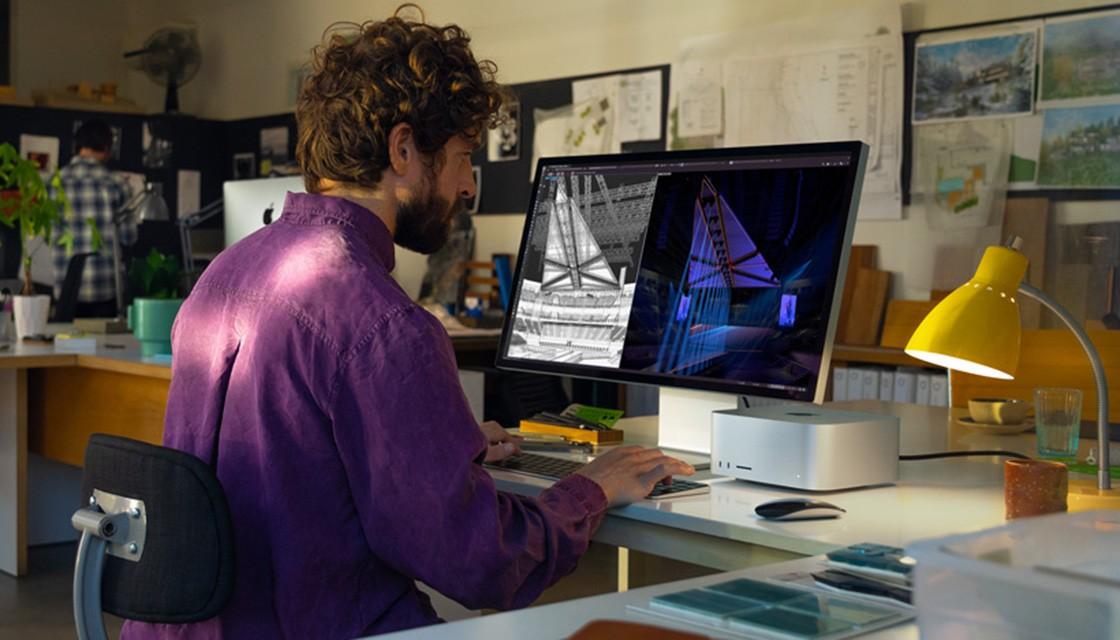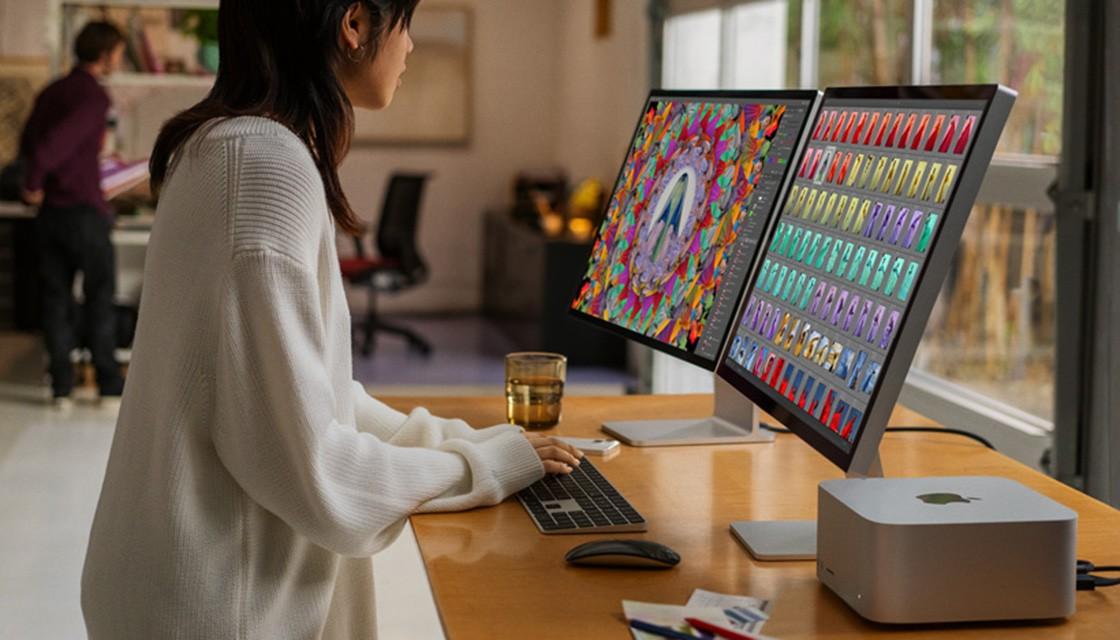
My first home computer had barely enough RAM to power Windows 3.1 and a 198MB hard drive, so it still blows my mind to hear about GBs and TBs in today's versions.
Apple's March announcement of its Mac Studio containing its new M1 Ultra chip with 20-core CPU, 64-core GPU and 32-core Neural Engine, along with up to 128 GB of memory and 8TB of SSD storage may actually be able to REPLACE my brain.
That kind of power is not something that comes cheap, but for those wanting impressive performances at a slightly more affordable price, the Cupertino-based company offers versions of the new Mac Studio with its slightly slower M1 Max chip instead.
I jumped at the opportunity to try one out in combination with the 27-inch Studio Display monitor announced at the same time.
I've been using an M1 Max Mac Studio with a Studio Display for a couple of weeks now here are my thoughts.
The good
With Apple you can virtually guarantee that whatever hardware you are buying, you're not going to be disappointed with how it looks and these two beauties are no different.
Style over functionality is definitely not Apple's thing, either, and so it should surprise no-one that both the Mac Studio and Studio Display are top performers.
I've come to calling the former my 'Mac Mini on steroids', because that's what is seems to be. It's desktop footprint is slightly bigger than my M1-powered Mini but offers more ports, but is still surprisingly small for its mammoth output.

The cooling fan alone on my gaming desktop isn't that much smaller than the Studio.
It measures just 7.7-inches square at the bottom and 3.7-inches high but has more than enough room on the back for four Thunderbolt 4 ports, a 10GB ethernet port, two USB-A ports, an HDMI port and audio jack.
If that's not enough, then throw in the SDXC card reader and, on my version, two USB-C ports on the front (the M1 Ultra version has two extra Thunderbolt 4 ports there instead).
That's enough ports to power up to FIVE displays at once - four Pro Display XDRs at 6K resolution over USB-C and one 4K display over HDMI - as well as change your phone and your keyboard at the same time.
If I was a good-guy hacker in a spy movie, this would be my set-up, with scrolling green code everywhere, hacked surveillance cameras showing me the mean streets of Auckland, a real-time plot of the antagonist's movements and still enough space on the monitors for social media, Netflix, a game or two and my internet browser.
With the M1 Max onboard and 64GB RAM there was nothing I could do to cause the Studio to have to think hard at all about what it was doing. Not only was there no spinning colourful circle indicating hangs, there was no real heat output either.

It is, without doubt, the fastest and most capable computer I've ever used and it made me dread having to send it back.
The Studio Display is a brilliant companion to the Mac Studio. The 27-inch 5K retina display offers a resolution of 5120x2880 pixels at 218 pixels per inch (ppi), and a maximum of around 600 nits of brightness.
Even in a well-lit room I was able to enjoy the brilliant picture and the deep colours without having to adjust anything.
There are an additional four ports on the Display, three USB-C and one Thunderbolt 3, all on the rear.
One of the more impressive features is the sound quality that comes from the high-fidelity six-speaker system and force-cancelling woofers.
Apple's own Spatial Audio is supported as well as Dolby Atmos for videos, and I'm simply not used to hearing such a true audio experience from a thin screen like this. It was wonderful.
Of course, there's a front-facing camera included to support video conferencing and those of us who like to take photos of themselves pretending to work hard.

The 12MP Ultra Wide camera has a 122 deg field of view and supports Centre Stage, Apple's technology that puts the focus on someone as they move around the room.
Some early reviewers had problems with the quality of streaming video, presumably caused by software issues rather than the hardware, which should be more than good enough for work meetings.
I never noticed the problem my review device, undoubtedly due to the issue being fixed via a software update. Or perhaps mine just wasn't afflicted with the same issue.
I enjoyed high quality chats with family and friends overseas, during which my video and audio was as clear as it's ever been. Indeed, the picture quality was commented on by a couple of people I conversed with. Guess my old webcam isn't up to scratch, eh?
The three-mic array undoubtedly helps with that audio quality, with a high signal-to-noise ration and directional beamforming used to ensure your voice is picked up and as much of the background nonsense as possible is ignored.

For the record, the Mac Studio plugged into my curved, widescreen LG desktop monitor using USB-C worked just perfectly.
My Windows laptop plugged into the Studio Display via USB-C also displayed fine - although not all functionality of the Display is supported for Windows devices. I'm not sure why you'd bother, though.
The bad
As already alluded to, with great power comes great responsibility... to pay the massive bill you're going to end up with.
There's just no getting around the fact these very professional devices are out of the budgets of those simply looking for a nice high-end computer for their home office. There are a multitude of options to configure the devices as you want - more RAM, more storage etc - all of which will add substantially to the overall cost.
You have to make sure you get that correct up front because you aren't able to change it after you've purchased, either.
For the lowest specifications of the computer and monitor combined, you're looking at forking out around $6598 in Aotearoa - which you'd think would be enough to get anyone up and going quickly. But it turned out not to be the case.
One of the big surprises for me when opening the box for the Mac Studio was the lack of keyboard, mouse or touchpad.

Ouch! Think of spending all those thousands of dollars and then having to fork out another few hundred bucks on top?
I'm guessing many who purchase the Mac Studio may already have their own preferred keyboard and mouse set-up, but still, if this was your first venture into buying a Mac I think you'd have a right to be let down by the lack of peripherals.
Equally surprising is the lack of HDR on the Studio Display, which many video and photography professionals would want to ensure a maximum range of tones in images. If you don't know what HDR is, then chances are you don't need it or want it, but it still seems something of an oversight given the intended audience.
As is the fact you have to pay extra if you want to be able to adjust the height of the monitor - a whole $700 more. Nope, that isn't a typo. $700 on top of a $3000 monitor to be able to move it up or down slightly.

You could buy a new desk, chair and set of Encyclopedia Britannica to sit the monitor on for that price!
Of course none of these issues are performance related. In my many hours of using the combo, I never noticed any issues no matter how much software I had running at the same time.
The verdict
If money is no object then why not max yourself out at the $18,298 you'll pay for the very best options of both the Mac Studio and Studio Display?
Believe me, if I was able to deduct that from my tax bill this year, I'd be very tempted. That's a set-up that's going to power anyone's needs for years to come.
However, I suspect there aren't many reading this who need such an extreme level of computing power in their lives.
And if you're asking yourself whether you need to spend $8698 to mimic the exact set-up I tried then the answer is very likely no. If you genuinely needed that level of performance, you'd already know what you'd expect to pay.

The Mac Studio and Studio Display together are a stunning unit that is going to make life much better for music, video, photography and other professionals but are beyond what most need on a daily basis, myself included.
I've taken to editing videos, playing with photographs and trying 3D rendering in order to justify the desk space and I've loved it, even if I'm unlikely to be doing those for a job anytime soon.
One final thing - while the Studio Display is great in partnership with the Mac Studio, I don't think I'd be buying it alone.
By itself, it starts at $2999 in New Zealand. You'll pay $3699 if you want one that both tilts and adjusts in height.
As wonderful as it is, unless you are a hardcore Mac only person, there are better, cheaper and bigger monitors available for significantly less you can use with Windows, Mac and more equally.
Regardless, using the Mac Studio is a real treat, and one I'm keen to keep repeating for as long as possible.
Newshub was supplied with a Mac Studio with M1 Max chip, 32-core GPU, 64GB RAM and 2TB SSD and a 27-inch tiltable Studio Display for this review.



